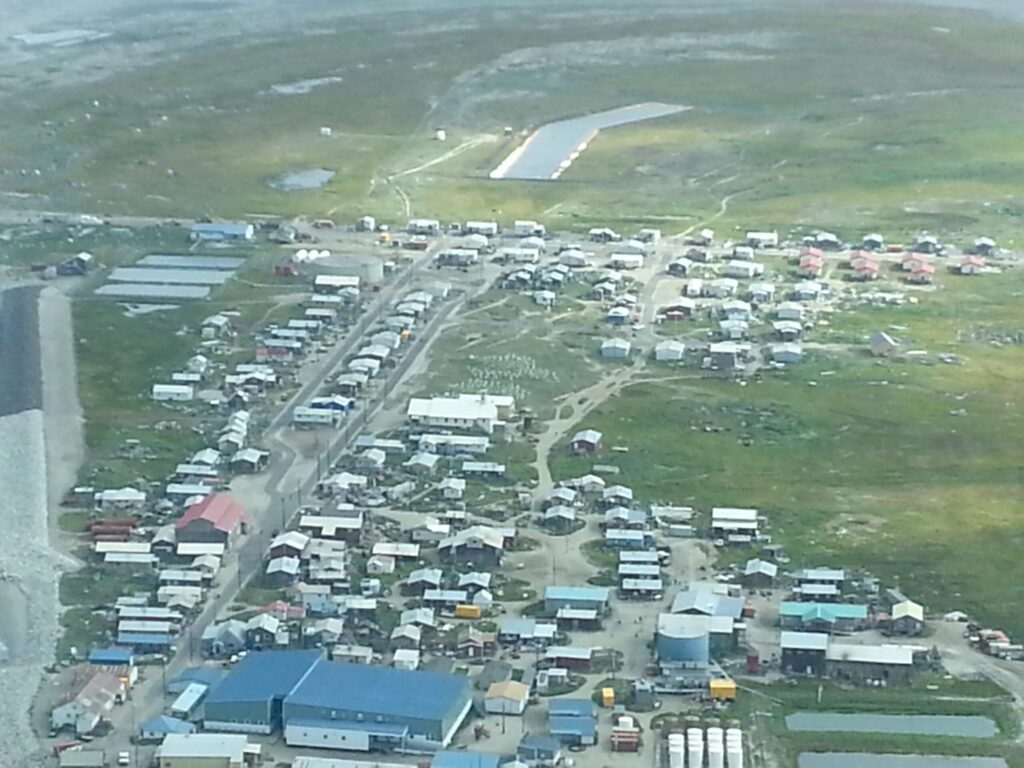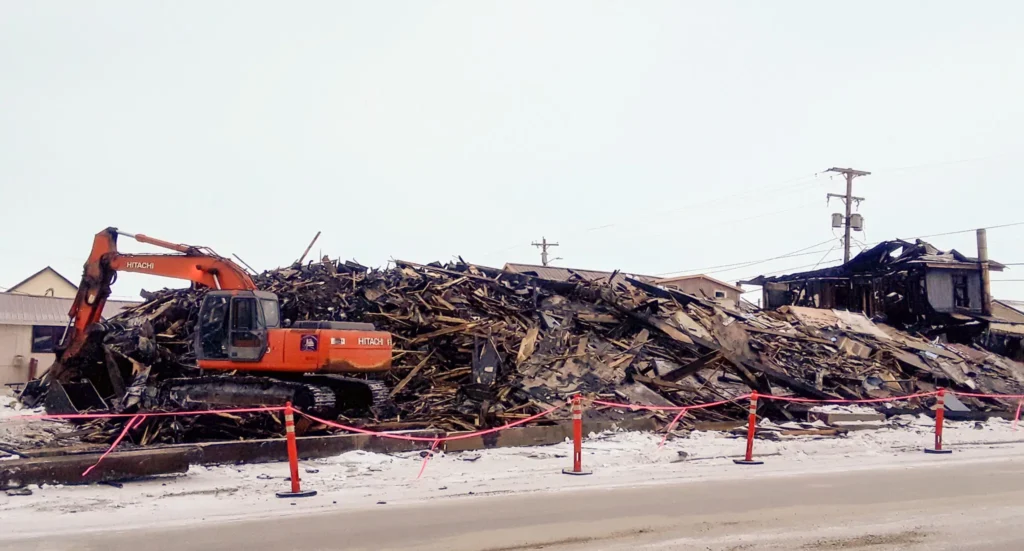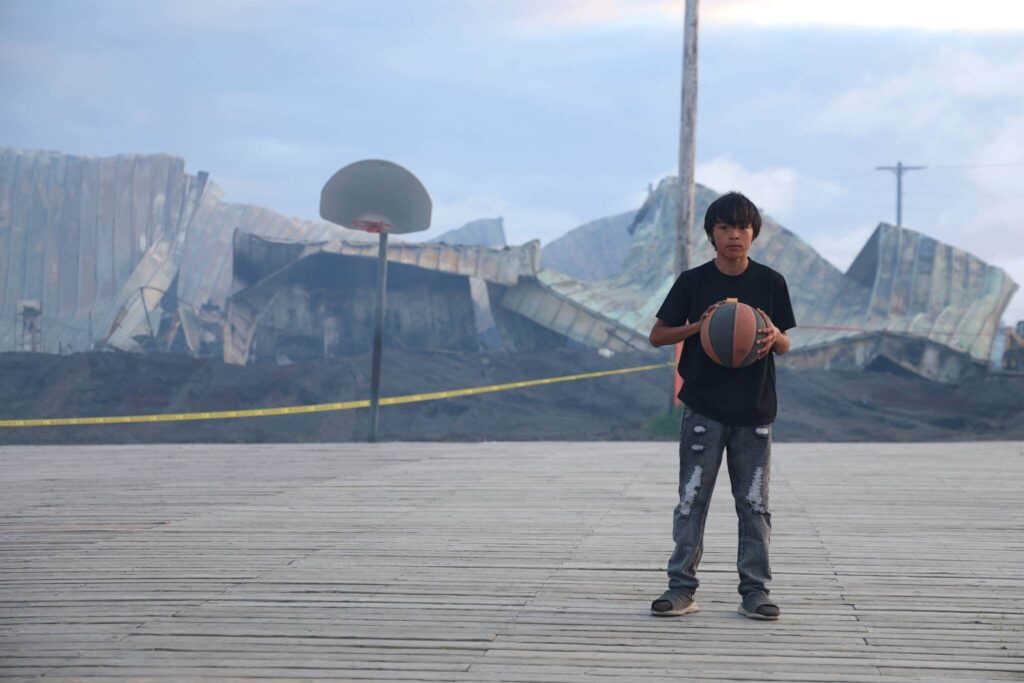Interior Secretary Sally Jewell was in the northwest coast community of Kivalina Monday, to hear what residents say are their concerns as erosion linked to climate change and rising sea levels threatens their subsistence way of life—and the very island the community is built upon.
Jewell was invited by the Alaska Federation of Natives to speak at their retreat in Kotzebue, an invitation that drew state lawmakers—including Governor Bill Walker and Lieutenant Governor Byron Mallott—to northwest Alaska to confront the secretary on recent federal decisions they say will limit oil and gas development on federal lands and waters across the state, including the Arctic National Wildlife Refuge and offshore oil exploration in the Chukchi Sea.
Jewell planned a trip of her own, to nearby Kivalina, about an hour’s flight from the Kotzebue hub. She planned to tour the village and meet with residents, to hear firsthand their concerns on a changing climate and a warming Arctic. Residents like Becky Norton, who has lived in Kivalina all her life, and has seen what erosion has done to the small community on a barrier island between the Chuckchi Sea and the Kivalina Lagoon.
“My husband built a cabin, with family, a two-story cabin about eight miles upriver,” she said, walking into town from the airstrip Monday afternoon. The wind was still and temperatures hovered around 20ºF. Norton said her family built their cabin “about 30 feet away from the bank. And the bank, where we are, it’s pretty high. When we park, we have to climb up and walk to our cabin.”
She said the cabin was used for years, a summer subsistence camp for her kids and her 22 grandkids.
But now the cabin is gone.
“This summer it fell into the river,” she said.
Norton’s cabin—and similar destruction linked to stronger seasonal storms that are eroding more and more of the community—took center stage at presentations for Secretary Jewell at the community’s McQueen School. Speakers, including a group of four students, outlined their concerns: namely, the ongoing struggle with erosion, the battle to fund a new school, and the emergency evacuation road required for the new school to happen.
All told, the school and road could cost upwards of $120 million. Solving the erosion issue, and possibly relocating the entire village, could cost millions more.
Jewell listened, made introductions, and posed for photos before hopping in the back of a pickup truck for a tour of the village with tribal president Millie Hawley.
“This is the home that was in danger of falling into the lagoon, until they put the rock revetments,” Hawley said.
“They put that on the outskirts, there?” Jewell asked, motioning to what appeared to be a pile of snow along both sides of the house.
“You can’t see it now, because it’s all covered with snow,” Hawley said, adding that the U.S. Army Corps of Engineers installed the revetments.
Further along the tour, the truck slowed along the side of the island that borders the Chukchi sea. In the distance, seal hunters were on the hunt and poised on the ice. “We used to be able to get fish out here,” Hawley said, “but we haven’t gotten fish for four years,” she said mostly due to ice conditions. When Jewell asked why, Hawley explained a “late start” to the annual ice now freezes to the bottom of the lagoon, “which stays until the fish have already migrated out to the ocean.”
Jewell’s tour ended at the airstrip, not far from the plane that would take her back to Kotzebue. Before she left, she saw the charred remains of the community’s only store, which burned down in December; the homes sinking, and sometimes falling, into the Chukchi Sea and lagoon; the brown tundra and jumbled ice that looked more like breakup than mid-February, which can often make caribou herds inaccessible.
Her time in Kivalina was brief, with every minute scheduled to keep her busy until her departure. But Jewell said it was worth the effort to see things firsthand.
“It’s hard to understand the impact in the abstract. When you see it up close, you really get a much better feel for the passion, the fear, the importance to culture and lifestyle that’s all at risk here,” Jewell said. “Not to mention just their lives, which are at risk on a little spit like this.”
When asked what she’ll bring back to Washington from her visit to Kivalina, Jewell said what she takes back will be “very real stories, stories from people who have personally experienced this change.”
A new school, erosion mitigation efforts the U.S. Army Corps of Engineers has already laid out, and more—all things Jewell said need to be part of the discussion when she returns to Washington. But concrete next steps remained elusive.
“I think the most important part is just trying to understand, what are the various moving pieces and prats that we can in fact influence,” she said. The new school is a state responsibility, Jewell said, adding that the Corps of Engineers should continue with projects already undertaken in Kivalina. “I don’t know what those [next] steps are going to be yet, until I go back and learn more about who’s involved. But what I do know is the situation out here is very serious, and it’s indicative of the kind of impacts we’re seeing in climate change everywhere, that this is probably the beginning of what may be to come in other areas.”
Tribal president Hawley said the secretary’s visit was brief, but in the end, she thought it was a success.
“I feel like we’ve done the job,” she said after the truckbed tour. “That was the main purpose, and we’ve done a good job with that, the village has done a good job with that.”
As for Becky Norton, whose family cabin fell into the river last summer, she said just how good of a job will be determined by what Jewell does next.
“It all depends on how she takes it, and pass it on to wherever it needs to go, to get us help,” she said. “And that’s all we need, is help. To continue with our evacuation road, relocation, and get our school built.”
Addressing Governor Bill Walker, and the host of other lawmakers who came to northwest Alaska to meet with Jewell, Norton said finding money for the community’s new school and road could happen if they want it.
“It’s priorities,” she said. “And our priority is the safety of our people. We can’t put a price tag on our family, on our kids. So we have to work hard to try and find solutions to protect them.”







